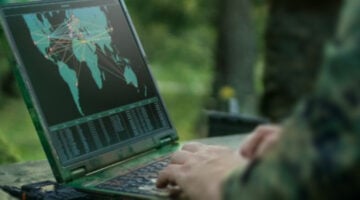
SPACE SYMPOSIUM: When China published its description of SJ-17, the folks at AGI who track satellites for a living raised their eyebrows.
The Chinese said it was an experimental satellite. But “the way they phrased it piqued our interest,” says Bob Hall, standing a dozen feet from AGI’s infamous ice cream stand here.
Our colleagues at SpaceFlight101.com offered a full description in December 2016 roughly a month after the satellite lofted into space atop the most powerful rocket China had ever launched:
“Officially, SJ-17 has been identified as a technical demonstrator satellite for a new satellite platform, testing higher-performance solar cells, new structural components, a green propulsion system consuming non-toxic propellants, and debuting a Hall-Effect Thruster system for use on future Chinese GEO satellites.
“Additionally, official media reported, Shijian-17 would be tasked with communications services, a demonstration of navigation in the high-orbit regime, and testing an imaging system for the identification of space debris at high altitude.”
The satellite, according to SpaceFlight101, uses “a combination of chemical & electric propulsion” which “strongly suggested SJ-17 was in for quite some maneuvering once reaching its planned orbit….”
And it certainly maneuvered an impressive amount, says Hall, who is director of AGI’s ComSpOC Operations. The ComSpOC tracks satellites and other objects in orbit.
Here’s a chart (prepared by AGI) of some its peregrinations:
| Date(s) | Event |
| 3 -11 Nov 2016 | Launch, initial GEO drift |
| 12 Nov 2016 | Rendezvous with Chinasat 5A (163 deg E) |
| 13 Nov – 28 Dec 2016 | Proximity Operations with Chinasat 5A |
| 25 Apr – 19 June 2017 | Relocated to 125 deg E |
| 20 June – 29 Sep 2017 | Parked next to Chinasat 6A |
| 29 Sep – 8 Oct 2017 | Relocated to 118 deg E |
| 11 Jan 2018 | Initiated Eastward drift |
| 10 Feb | Rendezvous with Chinasat-20 |
| 11 Feb – 16 Mar | Proximity operations with Chinasat-20 (as the pair drifted westward from approx. 176 deg W to approx.. 40 deg E)
Distance between objects generally under 10 km, several times within 1 km |
| 17 Mar – 14 April | Relocated to 115 deg E |
Now China, as far as we know, hasn’t done anything nefarious with this satellite. But it has approached to within “a couple of hundred meters” to an apparently dead Chinese communications satellite recently parked in the so-called graveyard orbit. That is incredibly close by space standards. (Also, that comsat may or may not actually be a dead satellite.) And, as space geeks can tell from the above chart, it has executed “proximity operations” with at least four Chinese satellites.
What does all this mean? Are the Chinese testing space war maneuvers to allow them to get close an enemy satellite to move it or disable it? Since the maneuvers to service a satellite — giving it new fuel or trying tor repair it, for example — are virtually indistinguishable from an offensive maneuver, we don’t know. We do know that Strategic Command’s Gen. John Hyten has made it clear China and Russia are building weapons that include satellites, lasers and other ground-to-space weapons. Russia has deployed three Kosmos satellites that appear designed to approach other nations satellites and destroy them. China has launched Shiyan satellites, reportedly able to use a grappling arm to move satellites.
China launched a satellite, the SJ-12, in 2010, which actually bumped another satellite. As a new Center for Strategic and International Studies report says, the SJ-12’s activities may have been intended to test counterspace activities — or not.
For its part, the US, has, of course, deployed the X-37B spaceplane. It spends extremely long periods in orbit and its locations are kept as secret as possible by cutting off data after a certain point in its launch and withholding orbital data. The X-37B can maneuver in space and possesses a decent-sized cargo area that could conceal a variety of counterspace tools. And there’s DARPA’s Robotic Servicing of Geosynchronous Satellites, which can help service satellites but, just as easily, maneuver close to an enemy satellite and push it out of position. RSGS is designed to reach satellites in geosynchronous orbit — 22,000 miles up — and then check for problems, repair them, and even install new sensors. But all those capabilities, of course, have a flip side.
Gen. Hyten has called for international norms in space, arguing that space is the only domain where the US military can’t create Rules of Engagement because there are aren’t any rules governing space war yet.
Meanwhile, we’ll be eager to see how China’s “dead” comsat behaves, along with its close friend SJ-17.

